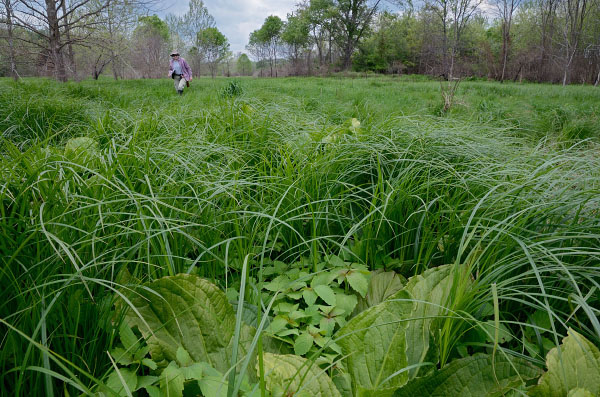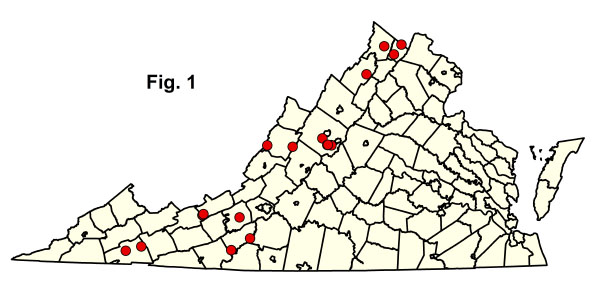
 Sở Bảo Tồn và Giải Trí
Sở Bảo Tồn và Giải Trí Bảo Tồn. Bảo Vệ. Tận Hưởng.
 Sở Bảo Tồn và Giải Trí
Sở Bảo Tồn và Giải Trí  Mục lục
Mục lụcĐầm lầy đá vôi và đầm lầy mùa xuân
Nhóm này bao gồm các mạch nước ngầm ở sườn đồi hoặc chân đồi có đá vôi; các vùng đất ngập nước và đồng cỏ giống như thảo nguyên trên các thềm đồng bằng sông hoặc suối luôn được bão hòa bởi nước ngầm hoặc nước rò rỉ từ các sườn dốc liền kề; và thảm thực vật giống như đầm lầy chiếm các vùng đất lầy bị ngập nước ngầm theo mùa trong cùng một cảnh quan. Những vùng đất ngập nước nhỏ này chỉ giới hạn ở một vài địa điểm tại các quận đá cacbonat thuộc tỉnh Ridge và Valley ở Virginia.
The vegetation of hillside/foot-slope fens is often a patch-mosaic of shrubs and herbaceous openings. Habitats typically have irregular or hummock-and-hollow microtopography, with areas of muck and abundant gravel or travertine marl deposits in the seepage rills. Soils, which are typically derived from underlying limestone or dolostone, are slightly to moderately alkaline with high calcium levels. Strictly defined, fens are minerotrophic wetlands with organic soils > 40 cm deep. Because they usually have only superficial organic soil layers, most of the Virginia communities in this group are technically "seeps," although we retain the term "fen" due to its wide application to various base-rich seepage wetlands in the southeastern United States; see Weakley and Schafale (1994) for additional discussion. Common shrubs include willows (Salix spp.), smooth alder (Alnus serrulata), swamp rose (Rosa palustris), alder-leaved buckthorn (Rhamnus alnifolia), and chokeberries (Aronia arbutifolia and Aronia prunifolia). Herbaceous species that are more or less diagnostic of calcareous fens or seeps include several sedges (e.g ., Carex flava, Carex hystericina, Carex interior, Carex schweinitzii, Carex suberecta, Carex tetanica), showy lady's-slipper (Cypripedium reginae), small-headed rush (Juncus brachycephalus), bog twayblade (Liparis loeselii), large-leaved grass-of-parnassus (Parnassia grandifolia), swamp lousewort (Pedicularis lanceolata), shining ladies'-tresses (Spiranthes lucida), and needle beaksedge (Rhynchospora capillacea). Other common herbs include bristly-stalk sedge (Carex leptalea var. leptalea), royal fern (Osmunda spectabilis), and golden ragwort (Packera aurea).
Vegetation of prairie fens is diverse and generally graminoid-dominated; patch-dominance of sedges (e.g., Carex stricta, Carex tetanica, Carex interior, Carex buxbaumii, Carex prairea, Carex suberecta, Carex trichocarpa), baltic rush (Juncus balticus var. littoralis), bald spikerush (Eleocharis erythropoda), common threesquare (Schoenoplectus pungens var. pungens), freshwater cordgrass (Spartina pectinata), switchgrass (Panicum virgatum var. virgatum) and, at a single known Virginia site, holy grass (Hierochloe hirta) is typical. Many low-cover forbs are also components, including several state-rare and unusual species, such as queen-of-the-prairie (Filipendula rubra), prairie loosestrife (Steironema quadriflorum), spotted joe-pye weed (Eutrochium maculatum var. maculatum), northern winged loosestrife (Lythrum alatum), hooded skullcap (Scutellaria galericulata), rough avens (Geum laciniatum), purple fringeless orchid (Platanthera peramoena), and marsh pea (Lathyrus palustris). Reed canary grass (Phalaris arundinacea) is a native perennial grass that frequently becomes invasive in disturbed wet prairies.

Calcareous Spring Marshes, sometimes referred to as "muck fens," occupy groundwater-flooded sloughs, abandoned meanders, depressions, and spring overflows on large stream or river floodplain terraces. Restricted to a few sites in carbonate rock districts of the Ridge and Valley region, these very rare habitats are highly threatened by impoundments and ditching, grazing, and agricultural pollution. Deep, hydric muck soils have high calcium levels and are more or less permanently saturated or flooded by perched groundwater or seepage inputs. Vegetation is marsh-like and characterized by coarse emergent species: arrow-arum (Peltandra virginica), bur-reeds (Sparganium eurycarpum and Sparganium americanum), water smartweed (Persicaria amphibia), lake-bank sedge (Carex lacustris), hop sedge (Carex lupulina), Virginia cutgrass (Leersia virginica), smooth bur-marigold (Bidens laevis), sweetflag (Acorus calamus), marsh-marigold (Caltha palustris var. palustris), skunk-cabbage (Symplocarpus foetidus), spotted jewelweed (Impatiens capensis), blueflag iris (Iris versicolor), and broad-leaved cattail (Typha latifolia). Buckbean (Menyanthes trifoliata) and water horsetail (Equisetum fluviatile), both very rare species in Virginia, are components at two sites each. A most unusual site in Clarke County consists of a 2 ha (5 ac) marsh developed in the overflow of powerful artesian springs. The marsh here is dominated by broad-leaved cattail and the state-rare, northern disjunct beaked sedge (Carex utriculata), while deep channels support the similarly disjunct flatstem pondweed (Potamogeton zosteriformis).
Tall grasslands occurring on moderately well drained to somewhat poorly drained floodplain terraces in mountain valleys of the Ridge and Valley region are included in this group due to their close association on the landscape with the fens. These communities, which are comparable to "tall-grass prairies" of midwestern states, are known from only a few sites in western Virginia. Their original, pre-colonial extent and the ecological dynamics which maintained them (e.g ., fire, grazing) are now conjectural. Some of the present-day occurrences may be artifacts of post-settlement clearing and grazing. Although these communities are included in the Palustrine system, some examples may not be wetlands in the strict sense. The hydrology of our few examples appears to vary from rather well-drained to seasonally saturated or even briefly flooded. Surficial soils vary from sandy-gravelly to mottled loamy-clayey, and from slightly acidic to moderately alkaline. The vegetation is dominated by the tall, warm-season grasses big bluestem (Andropogon gerardii) and indian grass (Sorghastrum nutans). Associated species with prairie affinities include willow aster (Symphyotrichum praealtum var. angustior), = Aster praealtus var. angustior), rigid sedge (Carex tetanica), eastern indian paintbrush (Castilleja coccinea), northern rattlesnake-master (Eryngium yuccifolium var. yuccifolium), dense blazing star (Liatris spicata var. spicata), Virginia mountain-mint (Pycnanthemum virginianum), and Culver's-root (Veronicastrum virginicum). Conversion to agricultural fields, cattle grazing, invasive introduced weeds, woody succession, and perhaps fire exclusion represent serious threats to these small, remnant prairies.
Các yếu tố sinh thái duy trì sự mở cửa của tất cả các cộng đồng này vẫn chưa được hiểu rõ và nhiều ví dụ dường như đang bị đe dọa bởi sự xâm lấn của cây bụi và cây gỗ. Việc đào mương, chăn thả và cỏ dại là những mối đe dọa bổ sung đối với các vùng đất ngập nước tự nhiên quý hiếm này, phần lớn trong số đó không được bảo vệ và cần được ưu tiên bảo tồn. Mặc dù một số quần thể của nhóm cộng đồng này nằm trong các khu bảo tồn thiên nhiên, một số quần thể khác vẫn không được bảo vệ và dễ bị tổn thương.
Tài liệu tham khảo: Artz và Krouse (1967), Carr (1939), Fleming (1999), Fleming và Coulling (2001), Fleming và Van Alstine (1999), Hunsucker và Mueller (1998), Ogle (1989).Nhấp vào đây để xem thêm ảnh về nhóm cộng đồng sinh thái này.
 © DCR-DNH, Gary P. Fleming.
© DCR-DNH, Gary P. Fleming.

 Tải xuống bảng tính thống kê tóm tắt thành phần cho từng loại cộng đồng được liệt kê bên dưới.
Tải xuống bảng tính thống kê tóm tắt thành phần cho từng loại cộng đồng được liệt kê bên dưới.

